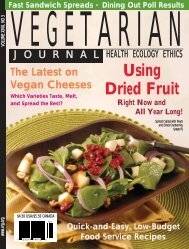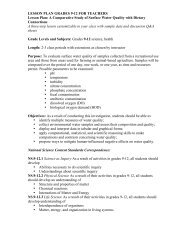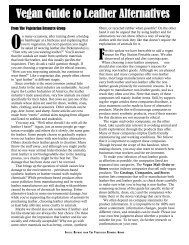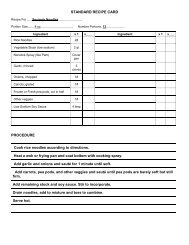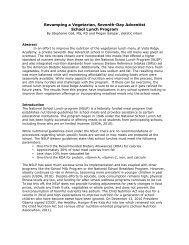Vegan Thickeners - The Vegetarian Resource Group
Vegan Thickeners - The Vegetarian Resource Group
Vegan Thickeners - The Vegetarian Resource Group
Create successful ePaper yourself
Turn your PDF publications into a flip-book with our unique Google optimized e-Paper software.
need a thick pudding consistency, use more arrowroot<br />
or use the more dependable cornstarch.<br />
Look for arrowroot in natural foods stores.<br />
Cornstarch<br />
Cornstarch was first manufactured in the 1840s. Made<br />
from a substance extracted from corn and processed<br />
into a white powder, cornstarch was originally used<br />
as a clothing starch. Food manufacturers soon discovered<br />
they could add it as a filler to processed foods.<br />
Cornstarch can be added to replace approximately<br />
a quarter of the flour in cake and cookie recipes for<br />
a finer grained, lighter product.<br />
My cornstarch-water mixture thickened faster than<br />
my arrowroot one did. Like arrowroot, cornstarch is<br />
said to revert to a thin consistency if cooked too long<br />
or stirred too much. (This may be the reason some<br />
cooks have better luck using wheat flour to thicken<br />
berry pie filling.) My thickened experiment had more<br />
substance than the arrowroot-, kuzu-, or tapioca-water<br />
mixture. However, cornstarch is more dependable to<br />
use if you’re aiming for a pudding-like consistency.<br />
My cornstarch experiment was clear when it was hot,<br />
but it turned opaque and was thicker when cool. It left<br />
a slightly chalky, unappealing aftertaste. If you have<br />
delicate flavors, it may be worthwhile to use arrowroot<br />
instead of cornstarch.<br />
Cornstarch is available in the baking aisle of any<br />
grocery store.<br />
Kuzu (also called kudzu)<br />
Kuzu has been used as a cooking ingredient in Japan<br />
for more than 2,000 years. Some cooks prefer to use<br />
kuzu instead of arrowroot or cornstarch because kuzu<br />
is less processed.<br />
In my experiment, I crushed the small hard kuzu<br />
lumps in a mortar with a pestle before measuring the<br />
kuzu powder into cold water. Always remember to do<br />
this before using it; otherwise, the lumps may remain<br />
intact. As my experiment heated, it was difficult to tell<br />
when the mixture had thickened because the texture<br />
was only slightly thicker than water after simmering<br />
for 10 minutes. I recommend using twice as much<br />
kuzu as cornstarch to thicken a sauce. When cooking,<br />
stir continuously or the kuzu will drift to the bottom<br />
of the pan, stick, and form a thick hard layer.<br />
Find kuzu in Asian grocery stores and in the international<br />
aisle or the macrobiotic section of natural<br />
foods stores.<br />
Potato Starch<br />
Made from cooked, dried, ground potatoes, potato<br />
starch can thicken hot liquids and is used as a binder<br />
in processed gluten-free breads and cookies. <strong>The</strong> package<br />
I purchased indicated that potato starch can be<br />
substituted for wheat flour to thicken gravy, sauces,<br />
or soups. However, in my experiment, the simmering<br />
liquid suddenly bubbled up and became a soft-gelled<br />
mass—not exactly gravy texture. For a gravy or sauce,<br />
my recommendation is to use less than half as much<br />
potato starch as cornstarch in a recipe and expect<br />
thicker results.<br />
Potato starch creates excellent texture when used as<br />
a binder in baked goods made with a gluten-free flour,<br />
such as rice, millet, or buckwheat flour. I use it almost<br />
exclusively to make my favorite buckwheat crackers.<br />
Use half as much potato starch as flour in a recipe.<br />
Potato starch is available in natural foods stores and<br />
in specialty markets.<br />
Rice Flour<br />
Used in Japan for centuries, this gluten-free flour can<br />
be sprinkled directly into a hot sauce or soup to thicken<br />
the texture. And it’s so easy to use that my gravy<br />
turned out perfectly with my first try. Start out with a<br />
Tablespoon of rice flour. Sprinkle over the simmering<br />
liquid. Add more as needed.<br />
Rice flour can be found in the baking aisle of many<br />
grocery stores and natural foods stores.<br />
Tapioca Flour<br />
Tapioca is a traditional ingredient in Brazilian foods,<br />
processed from the root of the South American cassava<br />
plant. Tapioca is available in granules, flakes, pellets,<br />
and flour, and it was the main ingredient to thicken<br />
pudding in the United States for decades until other<br />
ingredients replaced it.<br />
In my experiment, tapioca thickened the water<br />
like cornstarch did but with thinner results. Tapioca<br />
performs more like arrowroot in sauces. Use twice the<br />
amount of tapioca as cornstarch in a recipe.<br />
Tapioca flour shines as a binding ingredient in<br />
gluten-free bread, muffin, and cookie recipes. Use at<br />
least half a cup of tapioca flour for each cup of glutenfree<br />
flour.<br />
Tapioca flour is available in natural foods stores and<br />
in the baking aisle of some grocery stores.<br />
Wheat Flour<br />
My grandmother depended on wheat flour to thicken<br />
gravies, stews, and hot fruit pie fillings. Typical gravy<br />
VEGETARIAN JOURNAL Issue One 2007 15



